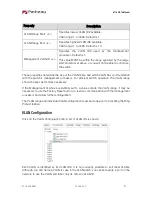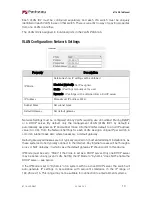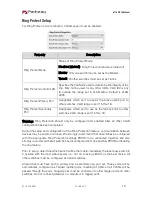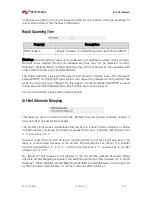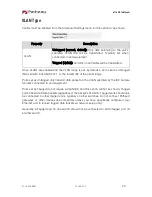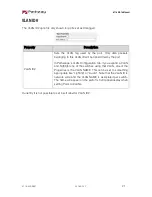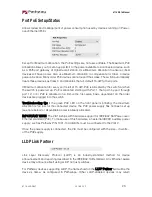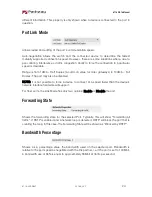
6716 VIA16 Manual
6716-200-REV1
2018-05-25
23
Port PoE Setup/Status
Allows review and management of power consumption used by devices running on Power-
over-Ethernet (PoE).
Except for Maximum Allocation, the PoE settings are not user-editable. The Maximum PoE
Allocation allows you to set an upper limit to the power available to a connected device, such
as a Pathport gateway of Vignette wall station. Use Maximum Allocation to ensure critical
devices will have power. Also use Maximum Allocation to compensate for Class 0 device
power allocation. Many older PoE devices cannot report their class. The switch automatically
treats these devices as Class 0 and allocates the full, default 15.4W to their ports.
If Maximum Allocation for every port is left at 15.4W, PoE is allocated by the switch: a) when
the switch is powered up, PoE is allocated starting with Port 1, then port-by-port through
port 12; or b) PoE is allocated on a first-come, first-serve basis, dependent on the order
devices are plugged into the switch.
Troubleshooting tip: If the green PoE LED on the front panel is blinking, the maximum
allocation is too low for the connected device, the PoE power supply has not been set up
(see note below) or all available power is already allocated.
IMPORTANT NOTE: The VIA16 ships with hardware support for IEEE 802.3af Power-over-
Ethernet standard (PoE). To make use of this hardware, an external 48VDC auxiliary power
supply, such as Pathway P/N 1001-100-48-DIN, must be connected to the VIA12.
Once the power supply is connected, the VIA must be configured with the size – in watts –
of the PoE supply.
LLDP Link Partner
Link Layer Discovery Protocol (LLDP) is an industry-standard method for device
announcement and reporting described in the IEEE 802.1AB standard. Any Ethernet-aware
device may announce itself using LLDP, not just switches.
For Pathway devices supporting LLDP, the name shown in the LLDP Partner field will be the
device’s name, as configured in Pathscape. Other LLDP-enabled devices may return

